Gooseberry diseases and their treatment
To get a rich harvest of gooseberries, it is important not only to choose a suitable variety and planting site, but also to know "by sight" the most common diseases and pests of the plant. Even if all the rules are followed, the berry can overtake fungal and viral diseases.
What to do if you are sick gooseberry and how to cure it? From the article you will learn what diseases are characteristic of gooseberries, how to recognize them and what measures to take when you notice the first signs of damage.
The content of the article
Gooseberry diseases and their treatment
Many diseases gooseberries are easy to recognize by the first symptoms - the bush withers, the leaves become thin and lethargic, covered with yellow or brown spots.
The causes of diseases are different - excess or lack of moisture, unbalanced diet, frequent changes in the weather. To fight disease with maximum efficiency, it is worth investigating the most common plant pathologies.
Scab
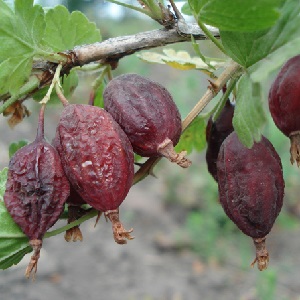 Why do gooseberries become like boiled ones? The reason for this is scab. This fungal disease is common in many garden trees and bushes.... The defeat begins with the leaves - velvety small spores appear on them.
Why do gooseberries become like boiled ones? The reason for this is scab. This fungal disease is common in many garden trees and bushes.... The defeat begins with the leaves - velvety small spores appear on them.
Over time, the spots on the gooseberry become larger in size, the berries are deformed and lose their attractive appearance. The pathogen multiplies on gooseberries in spring or summer, during the rainy season, warm weather and fog.
The reason for the appearance of scab is plant debris, garbage in the garden, weeds... Contaminated soil also contributes to the development of the disease, so it is important to treat the area before planting. If the bush is mature, gardeners remove weak shoots annually and leave 3-4 strong ones. It is recommended to regularly mulch and weed the plantings.
As a remedial measure, gardeners spray gooseberries with saline. (1 kg of salt per 10 liters of water) or a solution of copper sulfate. Another effective way is to treat the bushes with horsetail infusion (1/3 of a horsetail bucket for 10 liters of water). The infusion is left for 3 days in a dark place and the plant is sprayed.
Anthracnose
Gooseberry anthracnose appears on leaves and shoots... Small brown spots appear, which grow over time and turn into one large spot. Leaves from the upper branches crumble, the growth of young shoots decreases. Diseases develop actively in rainy summers - fungal spores love moisture and heat. Similar symptoms in another disease - gooseberry alternaria.
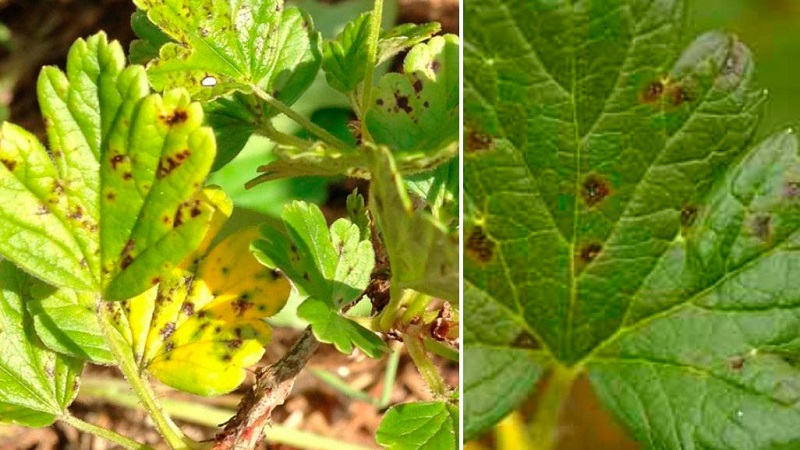
At the first sign of anthracnose, gardeners pick the infected leaves and treat the gooseberries with a solution of Bordeaux liquid... As a preventive measure, it is recommended to do this several times - before and after flowering, after picking berries.
Chemicals are used for treatment - "Kuprozan", "Kaptan". They are purchased at any gardening store. Before use, it is important to study the expiration date of the drug and carefully read the instructions for use.
Verticillary wilting
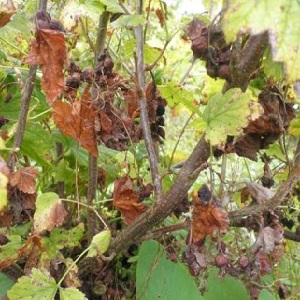 The disease attacks the root system and blood vessels - the leaves remain on the bush, but quickly turn yellow and wither... Due to root damage, whether the access of nutrients and moisture is disrupted, the bushes dry up. On the roots and on the cuts of the branches, a white fluff appears - mycelium.
The disease attacks the root system and blood vessels - the leaves remain on the bush, but quickly turn yellow and wither... Due to root damage, whether the access of nutrients and moisture is disrupted, the bushes dry up. On the roots and on the cuts of the branches, a white fluff appears - mycelium.
If the plant is already sick, gardeners remove the infected shoots and leaves... If the bush is completely affected, then the gooseberries are burned in the area directly with the roots.Otherwise, the fungus may remain in the ground, overwinter there, and next year attack other fruit bushes and trees. For preventive measures, gooseberries are treated with a foundationol solution (0.2% composition).
Attention! Many fungal diseases have similar symptoms - the appearance of spots, drying out, and deformation of the fetus. It is almost impossible to recognize the disease at an early stage, therefore it is recommended to take preventive measures in advance.
Rust
The disease got its name thanks to a yellow-orange bloom - it appears on leaves, flowers, ovaries.
Rust there are several types - goblet (small swellings are visible on the leaves) or columnar (yellow spots appear on the upper part of the leaves). Rust occurs for the same reasons as all fungal diseases - moisture, weeds, insects, lack of minerals.
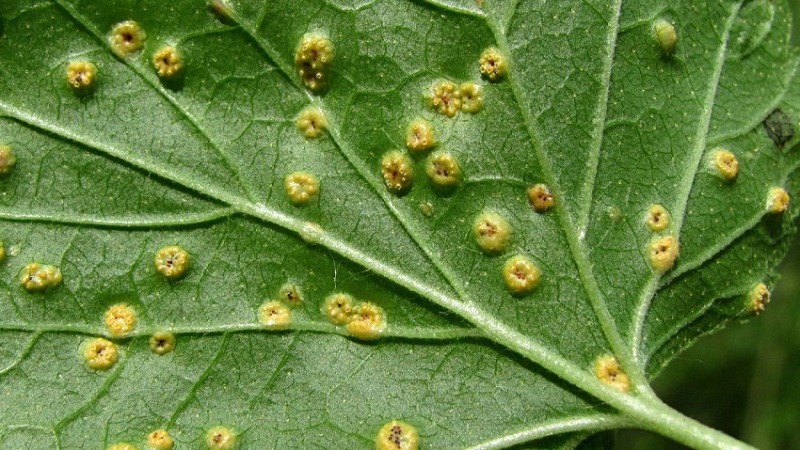
For preventive purposes, gardeners spray the bushes with mullein solution (for 3 liters of water 1 kg of cow dung) and regularly prune old and weak branches. For treatment, use means HOM, Topaz, Cumulus. It is not recommended to process gooseberries with chemicals more than twice per season.
Mosaic
Mosaic this is a viral disease, the pathogens of which hide in the infected soil and plant debrisas well as carried by wind, insects or birds.
Unlike fungal diseases, the mosaic is easy to recognize - a bright yellow pattern appears on the gooseberry leaves. After that, the plant stops growing, no ovaries are formed, the leaves are deformed.
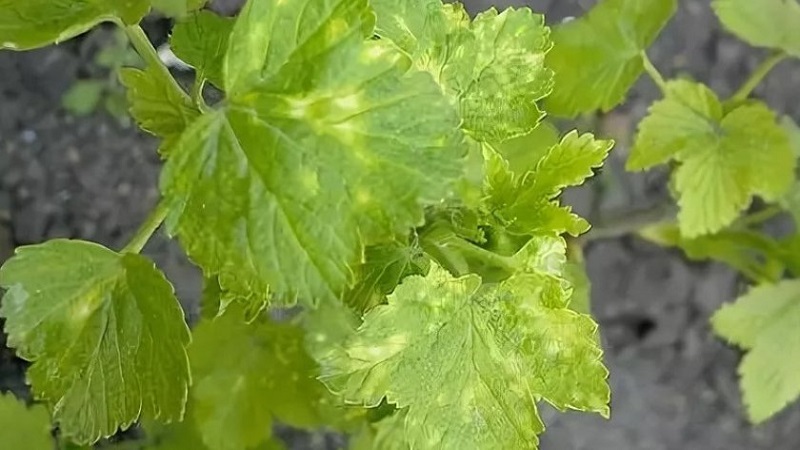
It's almost impossible to get rid of the mosaic - gardeners can only remove the infected gooseberry from the site and burn it. For preventive purposes, agrotechnical and chemical agents are used - they monitor the cleanliness of the beds, remove weeds and debris, and disinfect the site before planting. Gooseberries are sprayed with a solution of potassium permanganate and potash and phosphorus fertilizers are applied to the ground.
Septoriasis
The main sign of septoria is the appearance on the leaves of brown spots with a gray border.... After a few days, small black dots form on the spots - these are foci of mature infectious pores. After that, the leaves become wrinkled and curled, the bushes lose about 90% of their greenery. The causes of the disease are the lack of mineral elements in the soil (manganese, copper, iron), as well as the increased acidity of the soil.
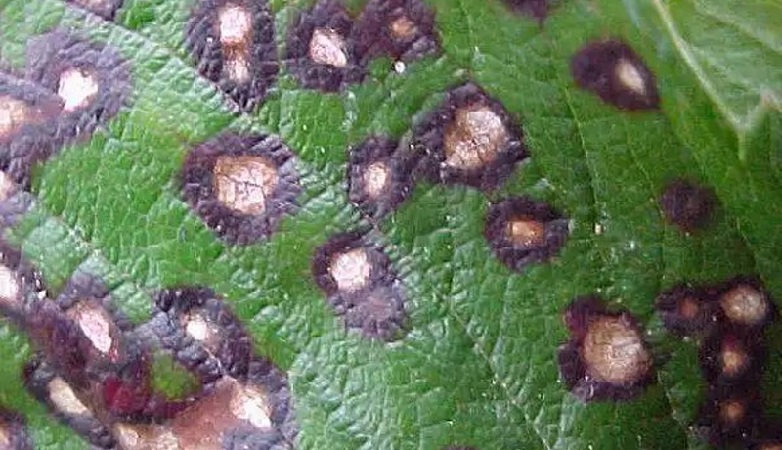
If the gooseberry is sick with septoria, it will not be possible to save it... In this case, gardeners collect all the fallen leaves and burn them away from the garden area. For the prevention of septoria, bushes are regularly hilled, the beds are weeded, and a balanced diet is monitored. An effective measure is spraying gooseberries with nettle infusion.
Powdery mildew
A common disease in most horticultural crops. Powdery mildew appears even on the most disease-resistant varieties... Hot and humid weather contributes to the development of the fungus, as well as an excess of fertilizers.
A white bloom appears on leaves, shoots and fruits. If you do not remove the affected areas, then after 2-3 days the plant will begin to rot, the plaque will turn gray. Powdery mildew can infect nearby plants - the fungus spreads quickly.
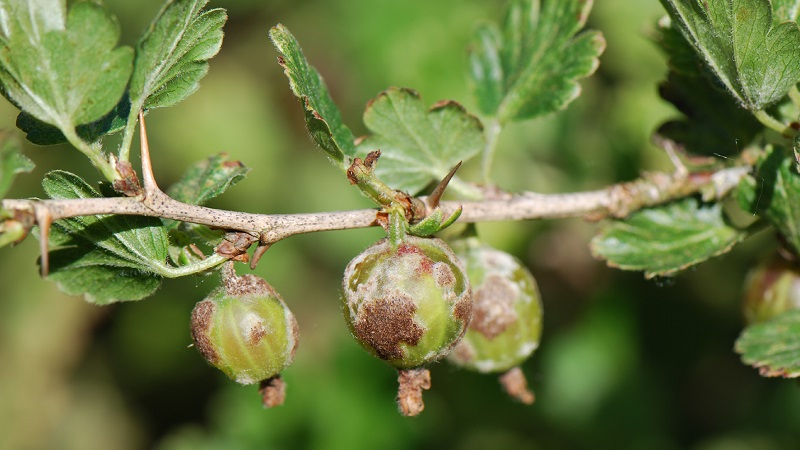
For prevention, gardeners spray gooseberries with a special solution - 5 liters of water, 60 g of grated soap, 6 g of salt. For treatment, fungicides are used - "Bravo", "Vectra", "Gamair". However, they will only help if the disease is detected at an early stage.
Attention! After powdery mildew, it is recommended to transplant the gooseberries to a new location. Before that, dig up and cultivate the land, disinfect seedlings and garden tools.
Gooseberry pests and control measures
Some pests feed only on gooseberry leaves, others - on ways to destroy the entire crop. Insects are attracted to weeds, so it is important to weed the beds regularly and keep them clean.
Mite
A spider mite is a small spider, about 0.5 mm in size, which is difficult to see with the naked eye. They feed on the sap of young leaves, which is why the latter slowly dry up and fall off.
The tick not only eats greens, but also lays eggs on the gooseberry. Spider mites reproduce especially quickly in hot weather - one female gives up to 8 generations per season.
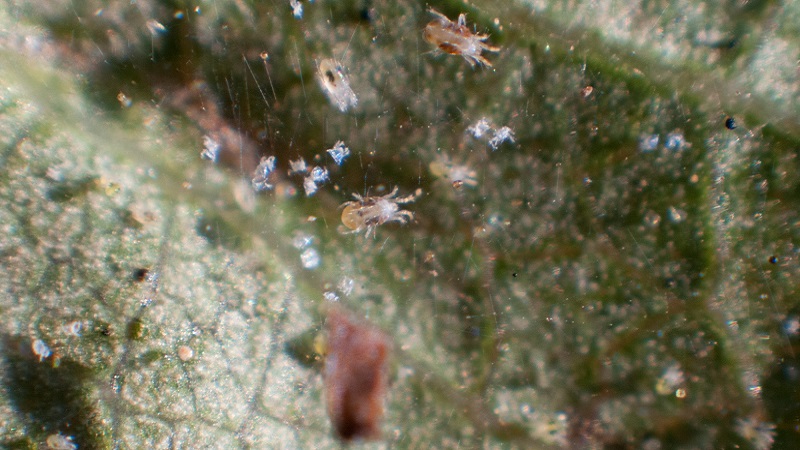
If ticks have just appeared in the garden, simple remedies will be effective in the fight. - treatment with a solution of copper sulfate or Bordeaux liquid, spraying with mullein infusion. In case of large-scale infection, gardeners use chemicals - "Credo", "Kolosal", "Tertsia".
Attention! A common way to combat spider mites is to water them with tobacco infusion. For preparation, 400 g of dry tobacco leaves and 10 liters of boiling water are required. The leaves are filled with water, left for two days. 40 g of grated laundry soap is added to the solution. Water for prevention and protection 2-3 times per season.
Aphid
Aphids settle on gooseberries in flocks... The insect is small, it is difficult to see it on the plant. Aphids suck out vital components from the leaves, because of which the gooseberry stops growing, the fruits are not formed. Over time, leaves fall, shoots dry up. Also, in addition to metabolic failure, aphids can carry diseases - tobacco mosaic and scab. Therefore, the insect is doubly dangerous.
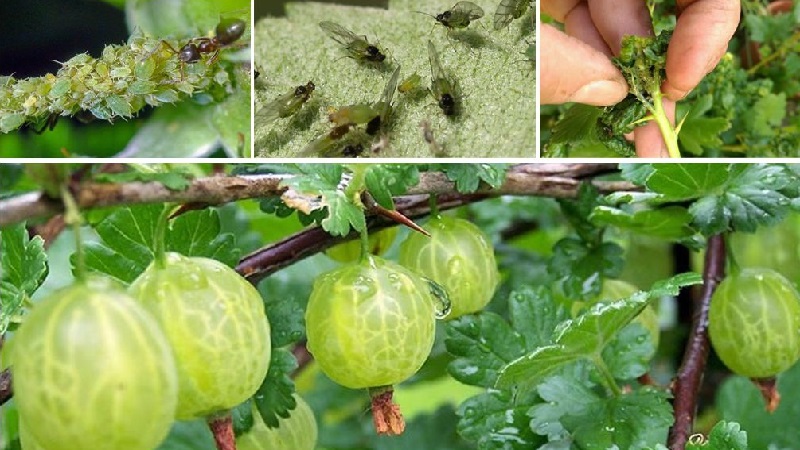
In the fall, aphids leave eggs on the shoots that winter successfully, therefore, in early spring, the bush is watered with boiling water. In the fight against the pest, a garlic solution helps - 350 g of chopped garlic is stirred in 10 liters of warm water. The solution is filtered through cheesecloth and poured over the base of the bush.
Sawfly
The sawfly at the caterpillar (larva) stage is able to completely destroy the gooseberry bushes, as well as nearby bushes of red and black currants. For this reason, it is recommended not to plant gooseberries with other berry bushes, it is better to give the neighborhood to potatoes, cucumbers, greens. Sawflies eat the inside of the leaf, gnaw holes on them. After 5-7 days, the bush is not able to develop further and bear fruit.

Comprehensive control measures are used against the pest - comply with agrotechnical rules, irrigation and dressing regimes. Gooseberries are planted on cultivated sunny lands, root and foliar fertilizers are applied. To exterminate the insect, use means Karate or Inta-Vir. Processing is carried out twice in the summer season.
Fire
The fire rat is easy to spot - these are large flying brown beetles... Outwardly, the moth looks like aphids, only of large sizes. It appears on the bushes with the onset of spring - it eats the flower ovary. As a result, the gooseberries turn red, dry out and become covered white bloom-the cobweb. When a moth is found, gardeners immediately remove damaged leaves and berries and burn them. The bush is sprayed with tobacco or garlic solution.
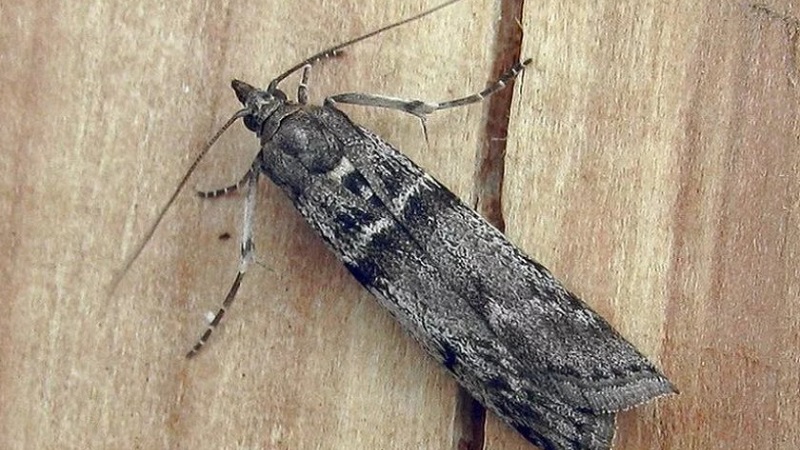
To prevent the appearance of moths, they dig up the ground near the trunk circle of the plant to a depth of 15 cm. This is done in the fall in order to avoid new larvae that appeared during the winter period with the onset of spring. In addition, it is important to prune old shoots in a timely manner and remove weeds.
Attention! Useful neighbors for gooseberry bushes are mint and tomatoes. It is recommended to plant them near the gooseberry, and no insect pests are afraid of the berries.
Moth
For gooseberries, both butterflies and moth caterpillars are scarythat are able to destroy all the leaves on the shrub. The butterfly larva grows up to 4 cm in length and has a thick body. With the onset of spring, it turns into a beautiful yellow-black butterfly. Inexperienced gardeners can rarely see a dangerous pest in it.
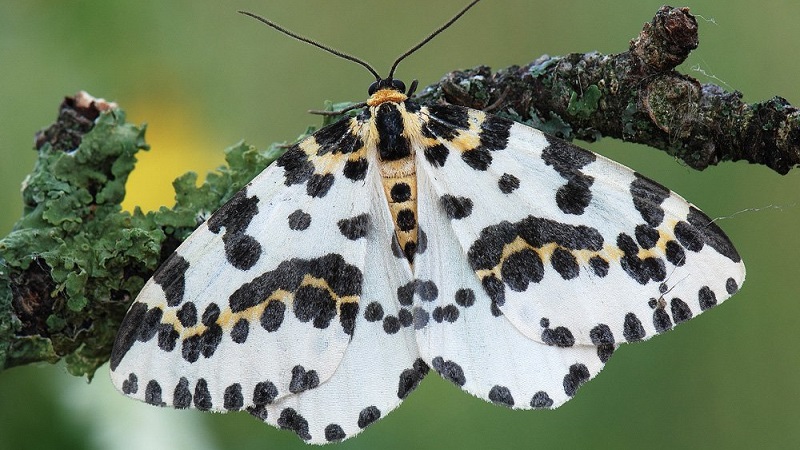
For protection, the bushes are treated with fungicides twice a season. - before bud break and immediately after flowering.If the bushes already have ripe and large berries, then using chemicals is not recommended - it is better to give preference to proven folk remedies. The moth lives on both mature bushes and seedlings.
Zlatka
In early summer, the green beetle lays eggs inside weak shoots.... In July, young beetles appear and eat young gooseberry leaves. The berry slows down in growth, and soon stops growing altogether.
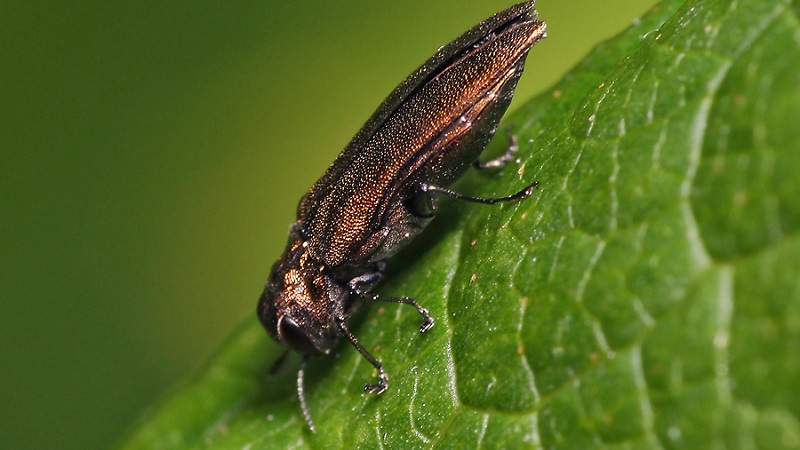
In early spring, weak and damaged branches are removedto prevent unexpected guests from arriving. If the goldfish has already settled on the bushes, gardeners treat the bush with the HOM preparation. But this is provided that there are no ripe berries on the branches yet.
Glass-maker
Glassware is a miniature white worm. A sign of the appearance of a glass pot is weak and fading shoots... Black spots are visible on the cut of the branch - these are the tunnels in which the insect lives. Planting processed and hardened cuttings will help prevent the appearance of glass.
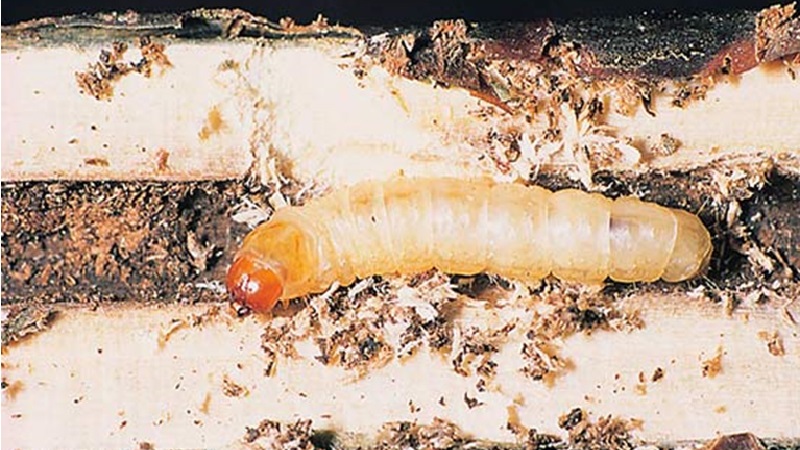
Glassware is able to withstand low temperatures, therefore, when planting a seedling on a site, it is better to cover it for the first time with a film or protective glass. It is advised to remove the structure after the plant gets stronger. It is also recommended to plant odorous plants near the gooseberry - calendula, marigolds, garlic. Fitoverm preparations are used to get rid of the pest.
Conclusion
Did the gooseberries turn red in June? Are the gooseberries boiled? If the gardener faced such situations in his garden plot, it means that the gooseberry is sick or pests have settled on it.
Fungal and viral diseases appear due to many reasons - moisture, heat, improper care, contaminated soil. Insects - due to weeds and diseases near plants. To protect the berries, it is important to inspect the gooseberries regularly for damage and symptoms. If detected, take action immediately.